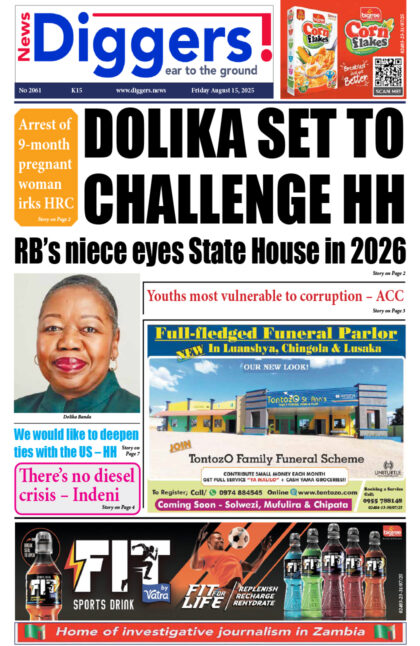BEHAVIOURAL change is the effective social vaccine for COVID-19, says University of Zambia founding Dean for Centre Health System, Metrics and Evaluation in the school of Public Health, Professor Charles Michelo.
And Professor Michelo says the fact that cases are increasing shows that as a country, there is something that we are not doing right.
Meanwhile, Ministry of Health Assistant Director for Health Promotion Dr Kalangwa Kalangwa says 80 percent of people who test positive for COVID-19 show only mild or no symptoms at all, but warns that people should not treat the virus as a hoax.
The two were speaking when they featured on Diamond TV’s Night Live program, Friday, which was sponsored by News Diggers under the topic “COVID-19 and Health”.
Professor Michelo urged Zambians to embrace behavioural change, saying the fact that cases were increasing showed that as a country, there was something that we were not doing right.
“It is not easy to differentiate [between a common flu and COVID-19] especially in a time and period like now when you have an outbreak. One way in which we are able to tell is by testing. The fact that the cases keep going up means there is something we are not doing well. And we should be asking ourselves ‘what is it we are not doing well in the response’? It maybe that there’s something we are not doing well now but it also means there is something we did not do well before at the time that we got exposed. What this is telling us is that there is community transmission going on,” said Prof Michelo.
“The vaccine that we have been talking about will take time. But we have something in our hands. Let’s describe this as a social vaccine, behavioural change.”
And Dr Kalangwa called on Zambians to up their game and sustain the COVID-19 preventive measures, saying the battle was not yet over.
He said 80 percent of people who tested positive for COVID-19 showed only mild or no symptoms at all, but warned that people should not treat the virus as a hoax.
“When we started with the response, we had good adherence to the public health measures. [But] there is a time when people started feeling that this COVID-19 is a hoax, it doesn’t exist and we saw relaxation in terms of people observing measures; masking, social distancing and handwashing. People have lowered their guard, but we are saying the battle is not yet over. This is the time people need to up their game. People have been asking that ‘how come in the beginning we had few cases’? We had few cases because people were doing very well. As soon as they lowered their guard we [have] seen cases going up. We are saying that this is the time when people need to sustain the preventive measures,” Dr Kalangwa said.
“In terms of COVID-19, over 80 percent of the people who actually get the infection tend to have mild or no symptoms. So when we say someone has gotten COVID-19, people should not expect the worst outcome from everyone. If you look at the number of people who tend to actually get serious complications, we have people who are in the risk groups, the eldery and people with underlying conditions. So if someone hears that their neighbour has COVID-19 and they were not admitted or had serious complications, that should not be taken as the disease not being serious. So the stages of the infection will differ in different individuals.”
Dr Kalangwa explained that COVID-19 was a respiratory virus which spread through droplets produced when someone was sneezing, coughing or talking.
“The virus itself [coronavirus] is a respiratory virus. Meaning that it spreads via droplets which are produced when someone is sneezing, coughing or talking. If someone coughs or sneezes and is within a short distance next to another person [and] if they (droplets) land in someone’s eyes, nose or mouth and they inhale, they are able to get it. The other way is, if someone coughs into their hands, for example and then shakes [another person’s] hands, while shaking hands if you touch your mouth, nose or eyes, you are able to get the virus,” he said.
And on the notion that the virus could be transmitted through the air, Dr Kalangwa maintained that COVID-19 was transmitted through droplets.
“From recent studies which were conducted and the guidance, is that the transmission is droplet based. So the virus in terms of the weight is not able to go beyond a metre. So in terms of transmission, when you say it’s airborne, for example TB, it means if someone coughs from this end, it can spread on a larger area. But for COVID-19, it’s droplet based. That’s why we are saying people should observe social distancing of one metre,” said Dr Kalangwa.
























